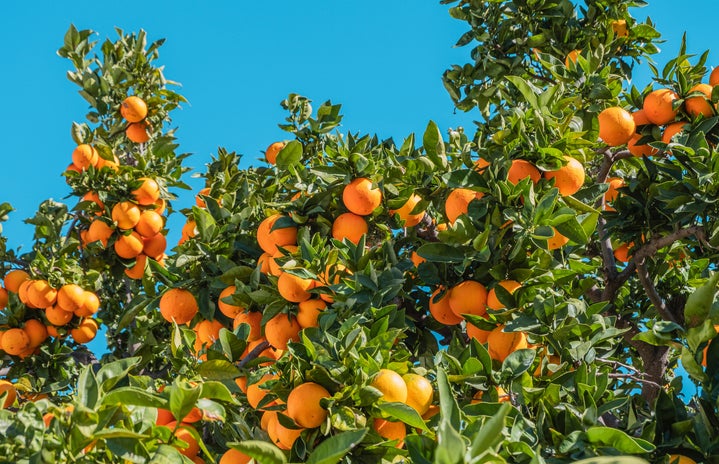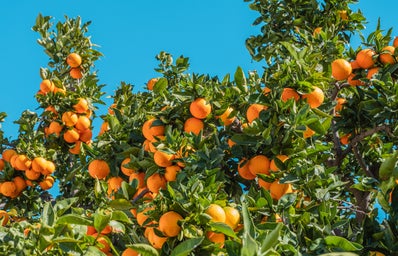From a young age, I knew how valuable citrus was to both Florida’s economy and its rich agricultural history. I grew up on the remains of my family’s old citrus groves, which were the source of income for many generations of my family. I descend from citrus growers, supervisors, salespersons and the like. Growing up, I spent my days outdoors, climbing the Citrus trees and playing in the dirt, all while eating delicious organic fruit I took for granted. It was a magical childhood that lasted until a citrus-killing disease entered the United States and plagued most groves in Florida, mine included.
I’ll never forget the day I first noticed something was awry. I was climbing my favorite grapefruit tree, book in hand and a plan to rest on my favorite limb that seemed to curve perfectly to the shape of my body and gave me a view of practically my whole yard. A limb gave out under me, snapping in half and falling below me to the grassy earth. Luckily I had not fallen with the limb, but I was dumbfounded at how the thick limb I had climbed every day for years seemed to crumble from under me. After a few months of treatments and consultations with local tree farmers, uncertainty turned to disappointment as my family learned that Huanglongbing (HLB), also known as “citrus greening,” had arrived in Florida.
HLB is a bacterium transferred by Asian Citrus psyllids (Diaphorina Citri), small insects that feed on Citrus leaves and stems. HLB kills Citrus trees because once a plant is infected, it has no cure. Since psyllids feed on plant sap, they spread the harmful bacterium into the plant’s phloem which induces metabolic and regulatory changes that damage the plant’s defense and transportation systems. Symptoms of infection include leaf mottling, dieback, deformed or discolored fruit, premature fruit drop, root loss and eventually the death of the tree.
So you can understand the rapid escalation of the situation, here is a timeline of HLB infection:
- 2005: Citrus Greening first detected in the U.S. in Florida
- 2012: California detects first infected residential trees
- 2016: FL economic losses due to Citrus Greening since 2005 exceed $8 billion
- 2017: Citrus Greening spreads to Texas, where 26 percent of commercial groves are infected and 40% of residential sites are infected
- 2020: California detects Citrus Greening in commercial trees for the first time
While farmers and scientists have tried battling the disease with insecticides and early removal of infected trees, no effective treatment has been used to successfully revive a tree or an infected grove. The only way to avoid contracting Citrus Greening is by buying pathogen-free seedlings for new planters, which end up becoming infected anyways when they mature.
On top of the environmental effects of major Citrus loss throughout Florida, Florida’s ecosystem is under further threat by the recent EPA approval of the antibiotic Streptomycin (STR) to combat Citrus Greening. In the U.S., STR has been used to combat certain plant diseases along with human medical conditions such as urinary tract infections. However, it was banned for a period of time after it was found to severely harm the diets of infants and young children in particular. STR is one of the few pesticides subject to regulation under the Rotterdam Convention, an International treaty (not ratified by the U.S.) designed to reduce the trade of “extremely hazardous chemicals.”
Even though STR is banned in more than 100 countries, the Environmental Protective Agency (EPA) controversially re-approved STR to treat Citrus Greening. Despite studies that prove its ineffectiveness in treating Citrus Greening, the EPA approved 650,000 pounds of STR to be imported to California and Florida. In contrast, the U.S. only uses 14,000 pounds per year to treat medical conditions. STR has been deemed “extremely dangerous” by the World Health Organization, both to the environment and the human body. STR can either be injected in the trunk or sprayed onto the tree, a treatment that has been approved without knowing its side effects on local mammals, which will inevitably ingest the antibiotic from agricultural runoff.
Florida’s farmers are outraged at the divulgement of funds towards an ineffective chemical that will dubiously harm Florida’s wildlife and increase human antibiotic resistance. Oral arguments began in January 2023 in a lawsuit questioning the EPA’s approval of STR as a pesticide, brought forth by a coalition of farmers and health and environmental groups. The lawsuit includes Beyond Pesticides, US Public Interest Research Group, Environment Confederation of Southwest Florida, Farmworker Association of Florida, Farmworker Justice, Migrant Clinicians Network, represented by the Natural Resources Defense Council, Earthjustice, and Center for Biological Diversity. In 2020, the Lancet published an article that identifies several crises the world is facing, with a focus on another “looming potential pandemic… [a] rise in multidrug-resistant bacterial infections that are undetectable, undiagnosed, and increasingly untreatable.” Many others from the agricultural health community are just as concerned, like Drew Toher, community resource and policy director at Beyond Pesticides, who says “Humanity’s dwindling supply of medically effective antibiotics is not worth sacrificing.”
The EPA’s response to Citrus Greening is deeply saddening to me when I think about the childhood I had, picking oranges right off the tree without having to worry about ingesting antibiotics or pesticides. While I know the Citrus industry in Florida will be forever different from when my Great grandparents started their Citrus business, F.J. Snell Groves, I hope that lawmakers and scientists will think of families like mine and strive to keep harmful chemicals out of Florida’s beautiful nature. For now, I will continue to dream that the future of the citrus industry holds a cure for Citrus Greening whilst maintaining Florida’s precious ecosystems.
Want to see more HCFSU? Be sure to like us on Facebook and follow us on Instagram, Twitter, TikTok, YouTube and Pinterest!


